Namibia 2019
Journey to Namibia September 2019
Geography
Namibia has around 820,000 km2 and approximately 2 million inhabitants. This means the lowest population density in Africa - 2.6 inhabitants per km2. It also means that on an area about ten times larger than the Czech Republic, there are five times less inhabitants than in the Czech Republic. The capital of Windhoek has 450,000 inhabitants, nearly a quarter of the country's population.
Namibia is one of the four countries in the world where you can go from one point to 3 further countries (the so-called quadrilateral), namely to Botswana, Zambia and Zimbabwe. The point is in the Caprivi Strip in the north east near Victoria Falls. Further border is with Angola in the north and with South Africa in the south.
My former connection with Namibia
I became acquainted with situation in Namibia in the second half of the 1970s during my stay in Angola. The Czechoslovak ambassador, who spoke fluent Spanish but not English, asked me to interpret for him from English in an interview with the president of SWAPO (South West Africa People's Organization), the organization fighting for independence of Namibia, Sam Nujoma. Sam Nujoma seemed young and energetic and was full of confidence as he spoke about the achievements of his movement. At that time he had no idea that the struggle for independence and his exile would last 30 years (SWAPO was founded in 1960 and Namibia achieved independence in 1990).
History
As usual in Africa, many tribes have been living in Namibia. The majority tribe is Ovambo (50% - it is the tribe from which SWAPO has originated), further Kavango, Herero, Damara, Nama (known also as Hotentots - herdsmen) and San people (Bushmen - hunters and gatherers). There are large deserts in Namibia (inland Kalahari and coastal Namib desert, which is situated along 2,000 km of the Atlantic coast), savannas and pastures, but the main overall problem is scarcity of water. Therefore, since the beginning of the known history, there have been fights for land between individual tribes, especially between the Herero and the Nama, which were further stirred up during the colonial times.
The first Europeans to enter Namibian soil in today's Walvis Bay were Portuguese Diogo Cao in 1485 and Bartolomeu Dias, the discoverer of the Cape of Good Hope, in 1487. However, the coast was very inhospitable and for a long time of no interest to colonial powers with the exception of Walvis Bay, which was seized by the British. In 1884, German businessman Adolf Lüderitz bought a large coastal area from Chief of Herero and the Germans declared a protectorate over the territory (Southwest Africa was one of the German colonies in Africa besides Togo, Cameroon and Southeast Africa, today´s Tanzania, which Germany lost as a result of the lost World War I). The reign of the German Empire over Southwest Africa lasted only 30 years (until 1914), but it is surprising, how strong traces it has left to this day. The Germans built roads, wells, and tried to settle and to promote farming. However, it led to further conflicts over the seized land, the most devastating one being the rebellion of the Herero, who teamed up with their former traditional enemies Nama and started to attack white farmers in 1904. The rebellion was brutally suppressed and resulted in three years of genocide. About 65,000 of the 80,000 Herero and about a half of the 20,000 Nama population were killed. Herero are currently seeking for a compensation for their suffering from the Federal Republic of Germany - intensive negotiations are underway how it should be carried out.
The Union of South Africa, formed by the merger of 4 provinces in 1910 (since 1961 Republic of South Africa) occupied the territory of present-day Namibia in 1915. After the war, the League of Nations mandated the Union of South Africa to administer the territory of South West Africa but instead it annexed it illegally as its 5th province and introduced the same laws of racial discrimination as in the Union of South Africa - apartheid. After World War II, it refused to recognize Southwest Africa's status as a UN trusted territory. The struggle for Southwest Africa's independence, today's Namibia, lasted 30 years. Its success was largely due to Angola, which allowed SWAPO fighters to place bases and refugee camps on its southern territory. It was a great sacrifice for Angola, because South Africa responded by air raids on the territory of an independent Angolan state and by other combat actions aimed at destroying SWAPO. During these years, many civilians, Namibians and Angolans, lost their lives - for example, a great international outcry was caused by bombing of the Cassinga refugee camp in 1978 (I was in Angola at that time). South Africa celebrated this action as a major military victory, but it caused great moral outrage in the world. 600 civilians were killed, including women and children. In the aftermath, the UN invited Sam Nujoma to address the Security Council, which subsequently issued a resolution No. 428 condemning the armed invasion of Angola, apartheid regime and the continued illegal occupation of Namibia, praising Angola for supporting the Namibian people and calling for free elections in Namibia supervised by UNO. In this situation, Cuban soldiers, who were invited by President Agostinho Neto and defended Angola against South Africa's aggression between 1975-1991, played an important positive role.
Those interested in more details, please see https://www.uncpress.org/book/9781469628325/visions-of-freedom/
After complicated negotiations that lasted for decades, UN Resolution No. 428 was fulfilled and in 1989 the first free elections were held under the auspices of the UN, in which SWAPO won 57% of votes. The independence was declared on 21st March 1990. Sam Nujoma as the first president gave a speech in which he stressed the importance of national reconciliation, similar to Nelson Mandela´s inauguration speech later when he became the first president of South African Republic after the abolition of apartheid in 1994.
Contemporary Namibia as per our experience -
Something New Every Day (slogan of our guide)
Prelude:
We flew from Frankfurt to Windhoek with Air Namibia. Before departure cargo was loaded for a long time, so we were delayed (we were already sitting on the plane). When they finally managed to finish loading, it was established that loaded cargo was too heavy so that the plane would probably not take off, which meant another delay because a part of the cargo had to be unloaded.
9 hours night flight was horror for me as always. But otherwise everything was all right on the plane, with the exception of the screen in front of us which remained unchanged with a single picture of Namibian landscape – no movies. The following explanation was given to the passengers: there is an internet connection on board and everybody can get his/her entertainment on his own mobile or tablet - a very modern way of economizing...
Day 1 - Windhoek, Namibia's capital city. We had a short sightseeing tour, visited local market, passed the Catholic Church of St. Mary and the Lutheran Church of Christ, passed the Ink Palace, an administrative building built for German administration in 1910 (allegedly too much ink was consumed there). Then we visited a school in Hoachanas that takes care of education of disadvantaged children and is supported from Germany.
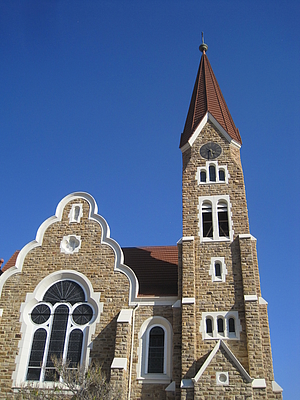

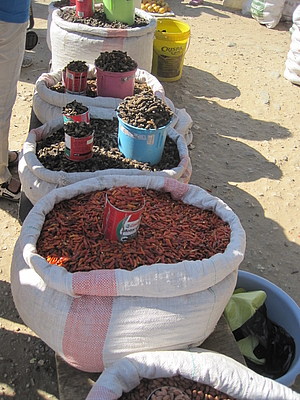


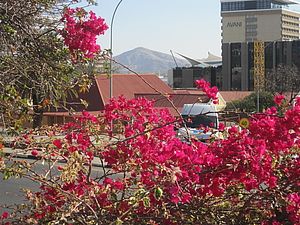
Day 2 - We celebrated crossing the Tropic of Capricorn, continued across the desert, drove through the red dunes of Kalahari, and watched the sunset of the red sun with a drink in hand.
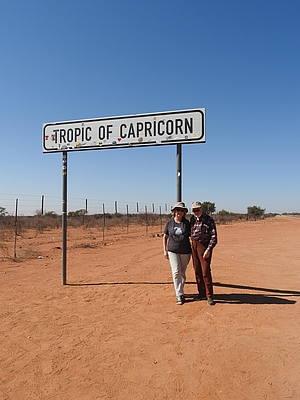
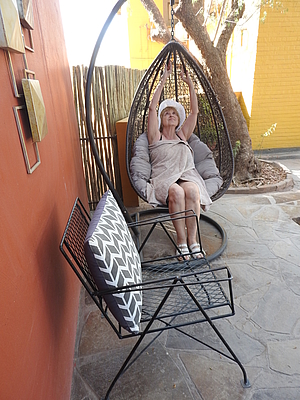
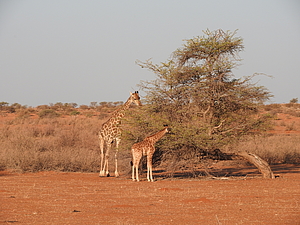
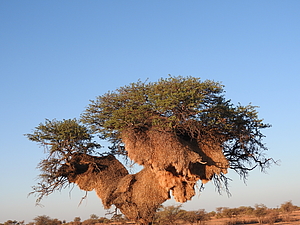
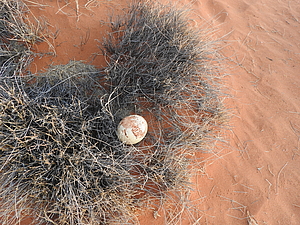
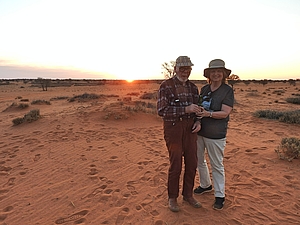
Day 3 - The biggest attraction of this day was the Quiver Tree Forest. The tree earned its name because Nama people made out of its bark quivers for their poisonous arrows (in Latin aloe ditochoma). They are endemic to Namibia and southern Angola. On quiver trees and other acacia trees, but also on mopane trees (butterfly trees the leaves of which resemble the wings of a butterfly), huge nests are being built by sociable weavers (Philetairus socius). However, these nests are also used by snakes, in particular by cobras which are eating bird eggs. To finish the symbiosis, scarab beetles are feeding on the bird droppings under the tree. In total contradiction with this unique nature, a collection of artifacts based on industrial wrecks is displayed around. Having an old used and rusted car or machine in front of the entrance as an artifact seems to be in fashion in various restaurants and cafés nearby.
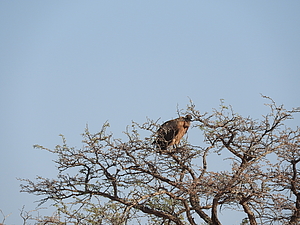

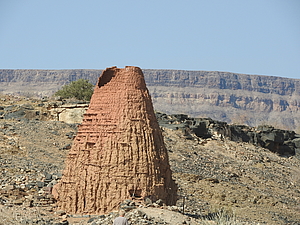
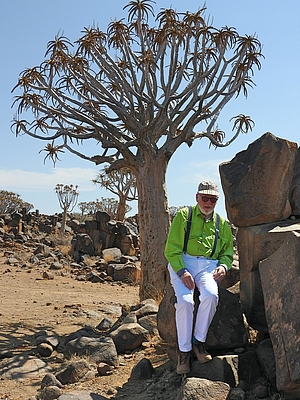
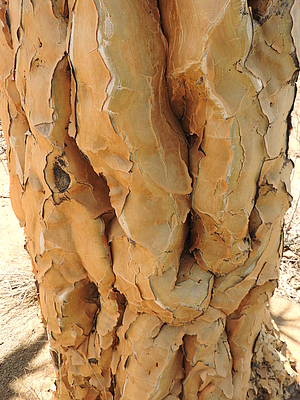
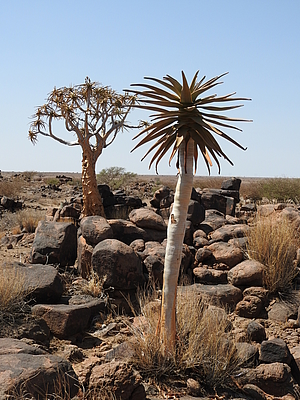
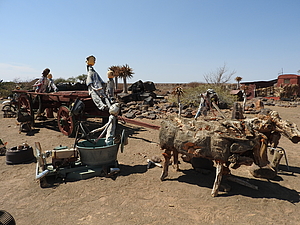

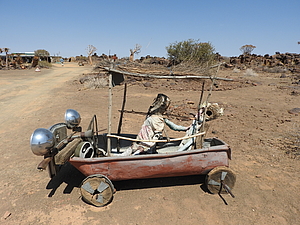
Day 4 - We had a coffee at Canyon Roadhouse Lodge, which again showed the art from the scrapyard. The biggest experience of the day was Fish River Canyon, after the Grand Canyon in the U.S.A. the second largest in the world, 150 km long, 550 m deep and in some places up to 27 km wide. The landscape was formed by a layer of rocks, mostly soft shales and sandstones, as a remnant of a prehistoric sea. For several millennia, the Fish River, which used to be quite wild during the floods, excavated a zigzag canyon. However, according to the legend of San, the incredible shapes were created by a fleeing giant snake. In the dry season, also in September, the river is completely dry, so it is possible to enter the canyon. When rains are plentiful, the gorge might be unexpectedly flooded in a couple of minutes.
The owner of the restaurant, where we stopped for lunch, owns a greenhouse with a large collection of lithops. They are also known as living stones or blossoming stones because they are succulent plants which resemble pebbles. They usually do not survive longer than 25 years in the wild nature, however, when artificially cultivated they can achieve an age twice as long.

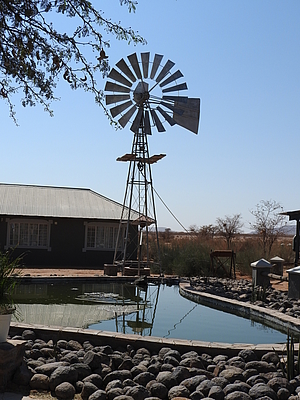
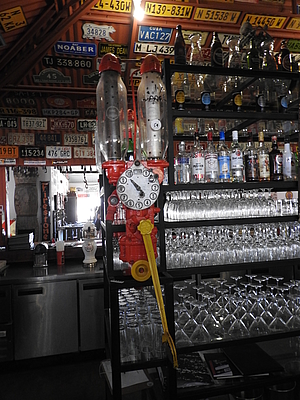

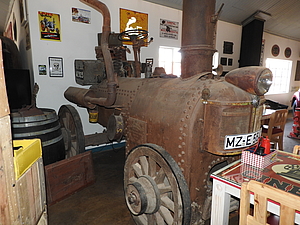
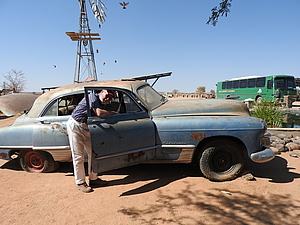
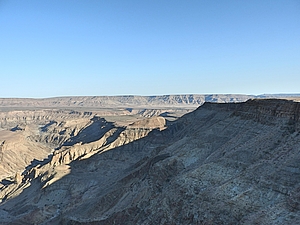
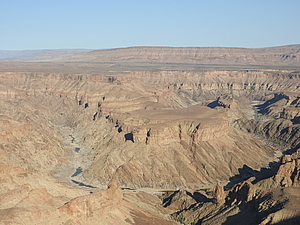
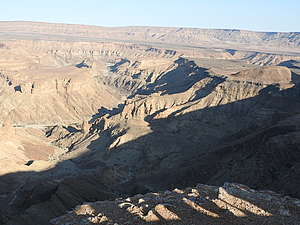
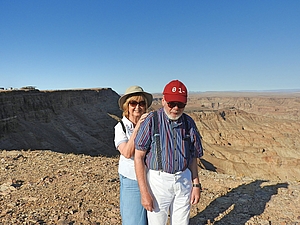

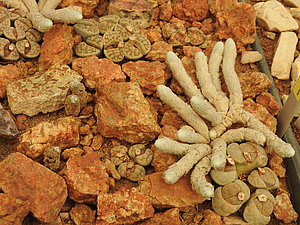
Day 5 - We arrived in Kolmanskop, a ghost town. In the past, plentiful diamonds were mined here, but when the diamond market broke down in 1929, the settlement was abandoned and left to its fate and is slowly sinking into sand. In the meantime it is partially maintained so that visitors could imagine what the life was in its heyday (hospital, school, even a bowling alley). The photos in an exhibition showed various methods by which employees tried to smuggle out at least some diamonds for themselves – in a shoe, in various devices, by arrow shooting or by post doves. Today, the majority of revenue of Namibia comes from diamonds (second is uranium). They are extracted in Namib desert, north from the border with South Africa in so called restricted areas and also from the sea.
We reached the fishing port Lüderitz, washed by the cold waters of the Stream of Benguela. German influence is still evident, there are many nice Art Nouveau villas in the town, everything is clean and tidy. After departure we stopped at a waterhole where Namibian wild horses come to drink (although the only real wild horses are Przewalski horses and Mongolian horses, all the others are actually originally domesticated horses which went wild, this is valid even for American mustangs). However, even if the origin of Namibian wild horses is disputed, it is wonderful to see them galloping in the wilderness.
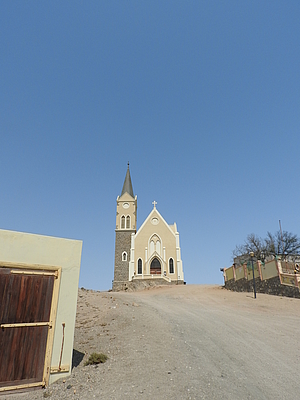
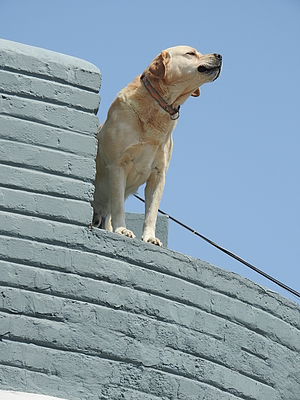
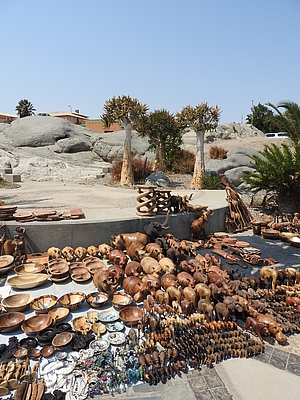
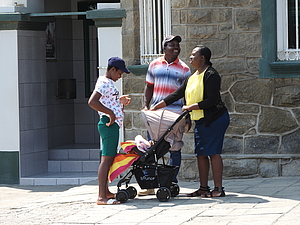
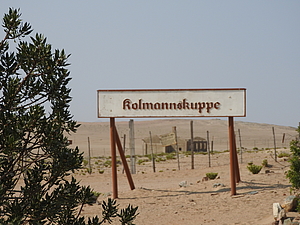
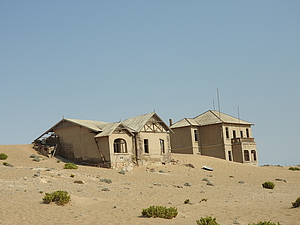
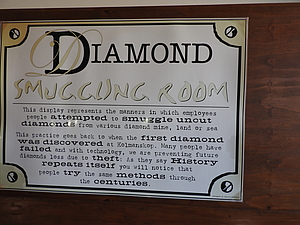
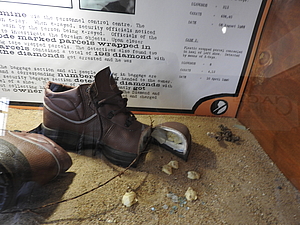

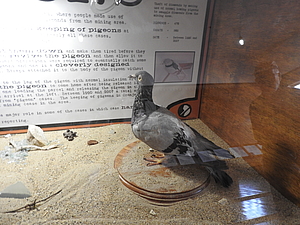
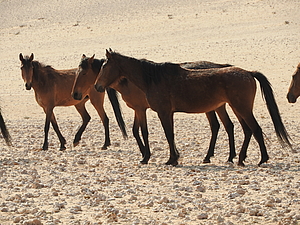
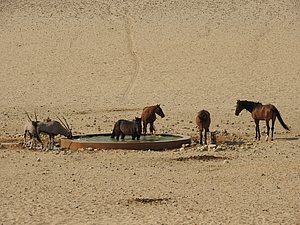
Day 6 - This day was a bit bizarre. Suddenly the pseudo-medieval Duwisib castle appeared in front of us in the desert. It was built by Baron Captain Heinrich von Wolf after he married Jayta, a stepdaughter of the American Consul. They bought land with an area of 35,000 hectares, began to build a castle and to grow thoroughbreds. The red stone for the construction was local, but everything else was imported from Germany to the port of Lüderitz, including iron, wood, cement, lights. The cargo continued then 700 km on wagons pulled by 24 oxen across the Namib desert. Von Wolf and his wife were both present whilst construction went on, however they did not enjoy much of the castle because the First World War broke out, Captain von Wolf volunteered and was killed already at the beginning of the war. The castle is now a property of the Namibian state.
A farm in a vicinity is managed by a German farmer Jochen Frank-Schulz, who prepared a delicious homemade lunch, offered a tasteful marmalade from cactus figs and shared with us his concerns about upcoming land reform. Fortunately so far there is no threat of confiscation of white farmers' land following the infamous pattern in Zimbabwe, but land is bought from farmers by state at an agreed price. The problem is that in Namibia, plagued by drought, farming becomes economical when the area of the farm is 25,000 square kilometers or more, otherwise the land does not suffice for feeding a profitable number of cattle, sheep, etc. When the land is divided into smaller lots, a farm stops to be profitable. Another problem is that while it is nice to try to remove poverty by distributing farm land, farming in Namibia is a difficult job which requires great dedication and know-how (maintenance of wells, pumping water, irrigation, solar panels, care of the cattle etc.), which new owners often do not possess. Many examples have proven that prosperous farms that were passed on in this way, failed in a very short time, in spite of support by state by cheap loans and other methods. Nowadays, farmers are often able to make their living only when some value added to the farm is possible - many farmers are involved in the tourism industry, either accommodating guests or providing safari or game hunting. This is also what our guide Friedrich and his family do (the older brother who inherited the farm from their parents, tries to irrigate and grow corn and vegetables for the market, the younger sister married a guy from Bavaria, bought 25,000 square kilometers of land next to the family farm and they offer hunting, Friedrich himself had built some bungalows next to his farm and is renting them).
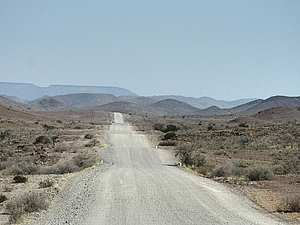
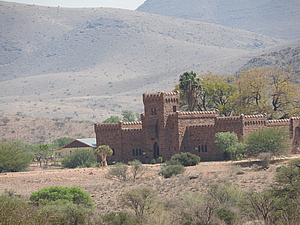
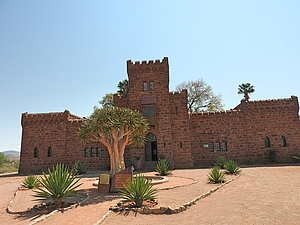
Day 7 - We drove through a rapidly changing landscape, first a flat wasteland where nothing grows, suddenly spiked-shaped rocks, in a moment for a change round-shaped rocks, and after that rocks flat as a Table Mountain in Cape Town, but this table mountain went on and on for kilometers.
Landscape full of yellow sand followed, otherwise nothing, and suddenly the beautiful dunes of Namib desert in Sossusvlei appeared in front of us. There is a 60 km long trail in the valley which passes through the dunes on the both sides. It is possible to ascend the dunes as they have a solid fixed base, so they do not move, a lot of sand rolls from their peak only during sandstorms.
When I started to climb, my head started to spin a little, because wading in the sand is much worse than in the snow which has a firmer consistency - it is like if you would be suddenly losing ground under your feet. So I did not climb too high, however, the play of light and shadow at sunrise on the dunes was fantastic. In addition, the desert is alive - we saw many oryx antelopes, a jackal, an eagle, sparrows and a few other birds, there are also various beetles. The oryx is the national animal of Namibia.
In the afternoon we descended into another canyon, or rather to an abyss, called Sesriem.
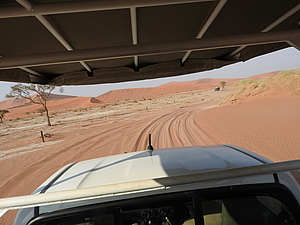
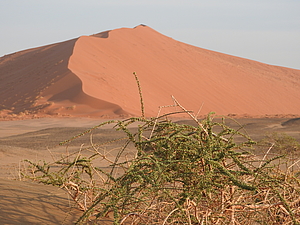
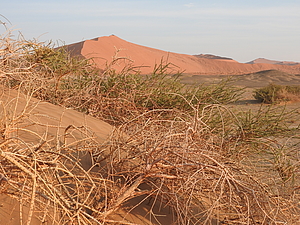
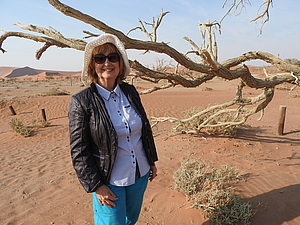
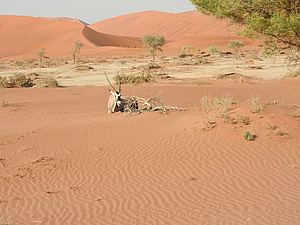
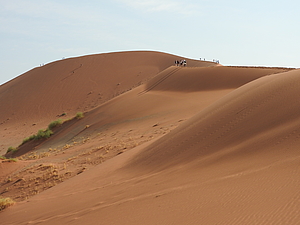
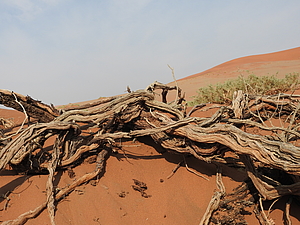
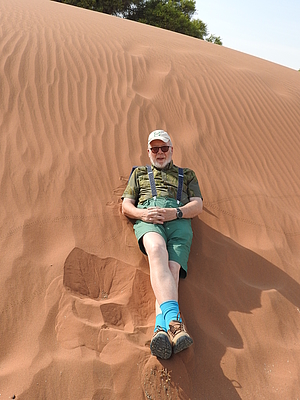
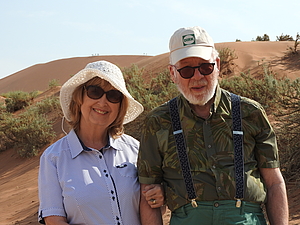
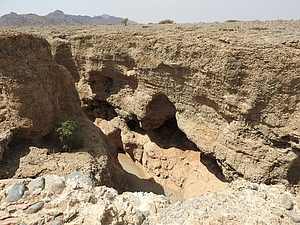
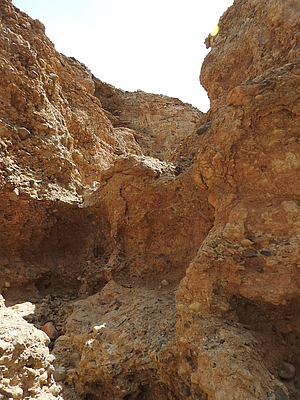
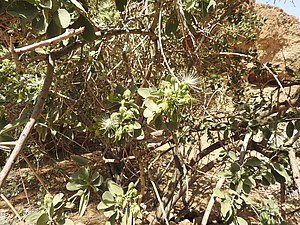
Day 8 - On a long trip to Swakopmund, to the Atlantic coast, we stopped to explore the moon landscape (although the evil tongues say a half of Namibia looks like a moon landscape) and we could admire a weird plant welwitschia in the desert (Welwitschia mirabilis). It is endemic to the Namib Desert and grows exclusively in extreme desert conditions. In some years it does not rain at all, the daily air temperature reaches 50°C and at night it drops to only 7° C. The plant obtains scarce water by its only two leaves from regular fogs, which stretch for about 300 days a year from the coast about 130 km inland. The longest found leaves are 6.2 m long (both live and dead) and 1.8 m wide. The highest plant is 1.8 m high, another one is 7.8 m wide. The leaf grows in good climatic conditions at the speed of 8 to 15 cm per year, by this parameter it is possible to determine the age of the plant, the estimated longest age being from 500 to 1000 years. It is an admirable plant, but indeed, it is no beauty, it may remind a pile of garbage from a distance.
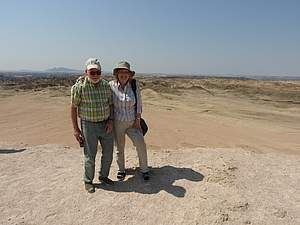
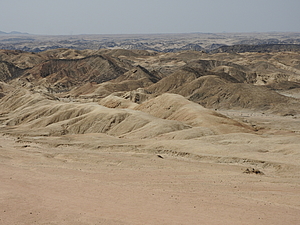
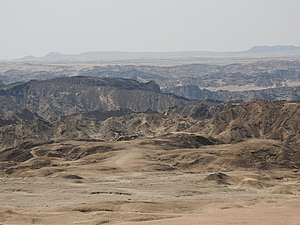
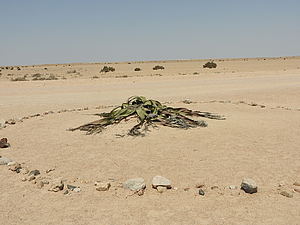
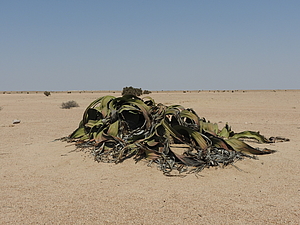
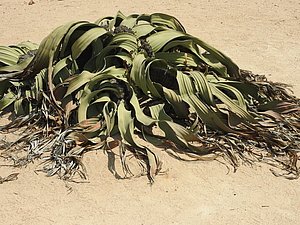
Day 9 - From Swakopmund we went to Walvis Bay for a catamaran ride. The sea lion jumped on board a few times and demanded his ration of fish, and the pelicans sat on the roof of the captain's cabin and were fed. Pelicans are the heaviest flying birds, they can weigh up to 15 kilograms and have a length from the tip of the beak to the end of the tail, depending on the species, from one to almost two meters. With a wingspan of three hundred and twenty centimeters, they are able to reach an impressive fifty kilometers per hour. Seagulls were also hovering above us, a number of seals were lying on a small island, and dolphins leaped up in front of the catamaran. After landing we saw a large colony of colorful flamingos on the coast. The captain and his assistant prepared oysters produced in local bays and farms and champagne for lunch.
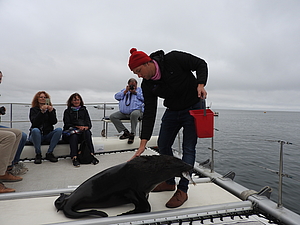
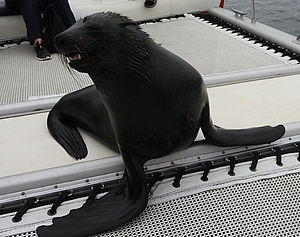
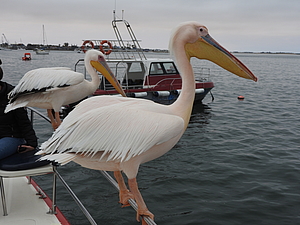
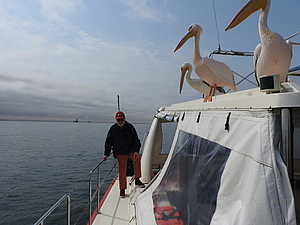
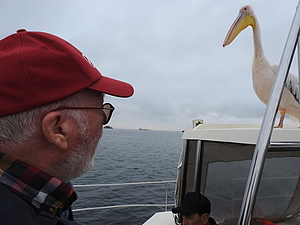


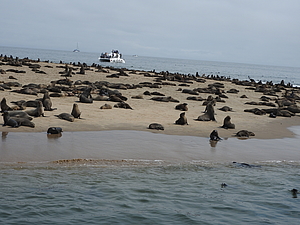
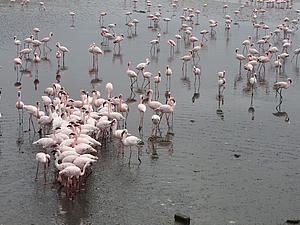
If the morning was devoted to animals, the afternoon was dedicated to people. We went to the Mondesa district, which was originally reserved by South Africans only for the colored population. It is still the poorest part of the city, with about 25,000 inhabitants, half of them unemployed.
First we went to a kindergarden, which is managed by a big woman belonging to Herero. She presented herself in a costume typical for her tribe, including a two-horned hat, symbolizing a cow, but otherwise inspired by the Victorian era in Britain. Her name was Gloria. She explained among other things how it works with marriage and relationships in her tribe.
1. Two people meet, get together and get married in the church - not much difference to the European customs (90 % Namibians are Catholics or Protestants, but there is also an indigenous religion that invokes fire).
2. Those interested in marriage who cannot find anybody ask for help an intermediary called “uncle”. It is said that these mediated relationships endure best and longest.
3. Because Herero men have the right to have as many women as they can afford and need for the good functioning of their household, the man chooses the first woman, pays 2 cows to her parents, and all the other women are being chosen for him by this first wife. If she is doing well with him, then she chooses her sister, best friend, cousin, as the next wives, so that they would have a good life as well. For each wife, husband has to pay two cows. The first woman remains the first woman forever, only giving instructions and directing the others.
Gloria explained that 90% of Namibians believe in one god, but there are also animists who worship sacred fire as their deity. In the smoke of fire, they also "bathe" because water is scarce. They are wrapped in a piece of cloth, throwing fragrant herbs into the fire and immerse themselves in the smoke.
Gloria's nursery gives a chance to small children without good family support. All children, not only Herero, aged between a few months and 6 years are welcome. She has currently forty of them. She can speak different local languages, but tries to make all children learn English. As it was Saturday, those children who have parents were at home with them, we saw only four sleeping children on the mattresses.
The second visit was to a healer in the center, which focuses on women's empowerment. The women sang for us, then the healer introduced her herbs which we were allowed to smell. The souvenirs that women produce are for sale, when someone buys something, the woman who made it gets the money directly - I bought necklaces composed of beads cut from an ostrich egg. The exhibition of toys for children from different tribes was interesting as well. A little cute baby boy caught up with me right at the beginning and he didn't want to let me go, he didn't move a step away from me all the time.
As next we were invited by the boss who is organizing these visits to Mondesa. The local youngster band sang and dance in the courtyard. The driver who drove us around was explaining also other aspects of the neighborhood. He told us that, like many others, he was raised by single mother. The reason for such a repeated situation is ignorance about contraception and masculine irresponsibility, especially in the turbulent times of struggle for independence. He came from Nama tribe and tried to teach us a peculiarity of Khoisan languages which contain clicks. Clicking does not have any meaning as such, but it can completely change the actual meaning of the word, for example, to love and to kill sounds the same, but a click added to it makes all the difference (there are 4 types of clicks, used mostly by Herero and Nama, which have around 250 000 speakers).
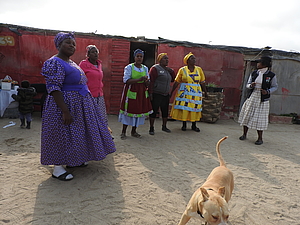

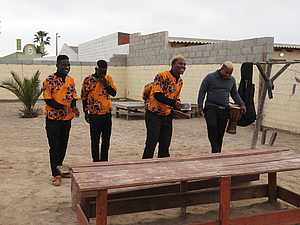
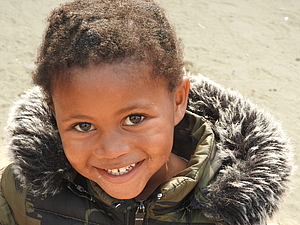
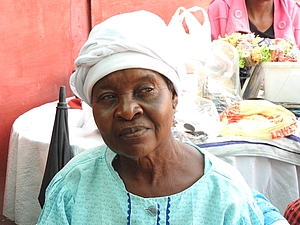
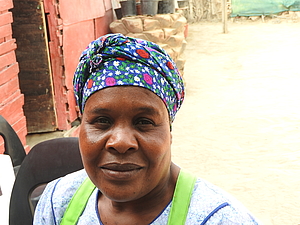

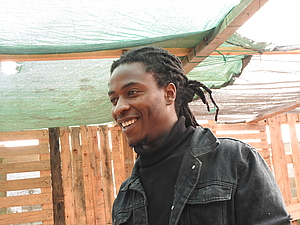
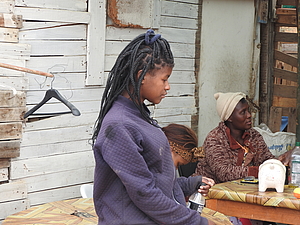


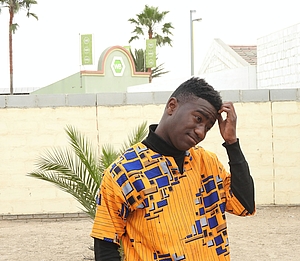
Day 10 - We headed to the Skeleton Coast, which begins with a shipwreck that slowly crumbles in the Atlantic. This was followed by a meeting Herero from the village by the road, who offered their goods for sale. In the Erongo Mountains, there is an area called Twyfelfontein where the largest rock art gallery in Africa is located. The works here are called "carvings in stone" because ancient artists created them by cutting into a hard coating that covers the local sandstone. The works date back to more than 6000 years ago, the Early Stone Age. They contain mainly animals, animal tracks and geometric shapes, very few human figures. All of this is located again in the middle of beautiful nature, as well as our lodge, where we stayed overnight.
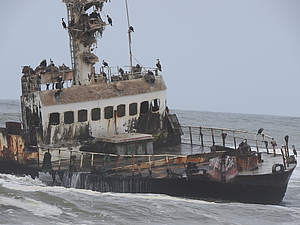
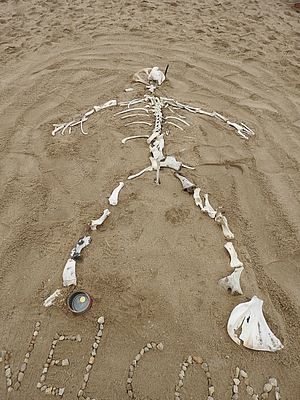
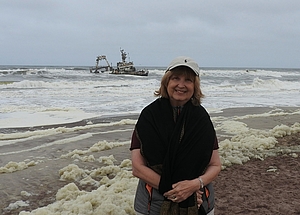
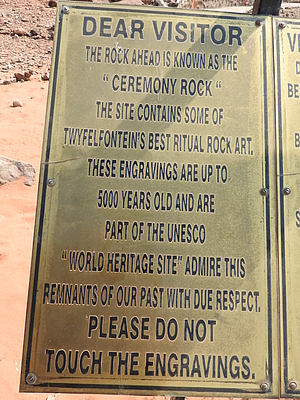
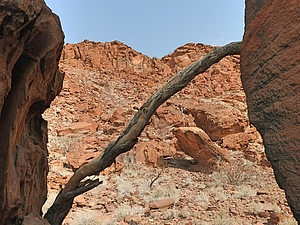
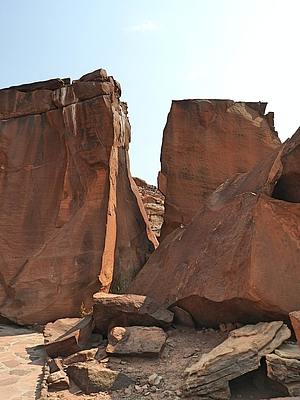
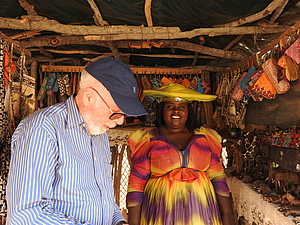
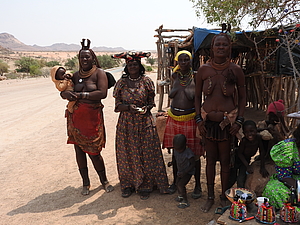
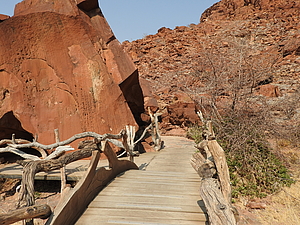
Day 11 - We saw a number of unusual formations. These included termite mounds, but also various rock formations: a Petrified Forest (280 million years old fossilized tree trunks), Organ Pipes (a group of columnal basalts), both near Khorixas , and Ugab terraces with a 35 meter high towering Vingerklip (Finger cliff). In the evening we arrived at Etosha National Park.
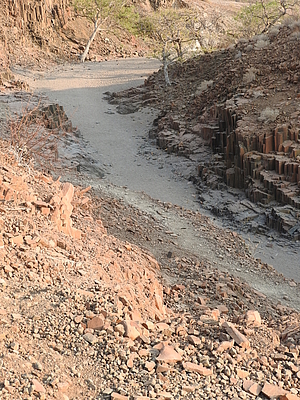
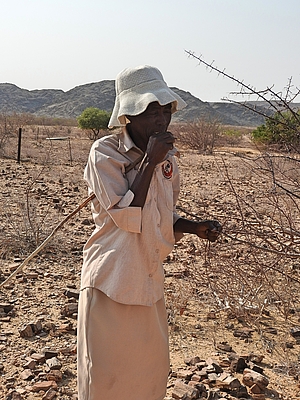
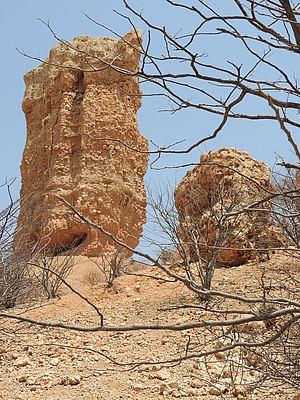
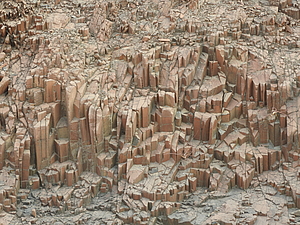
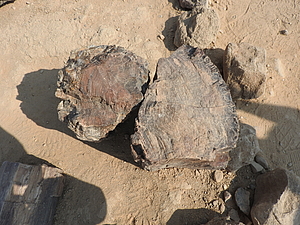
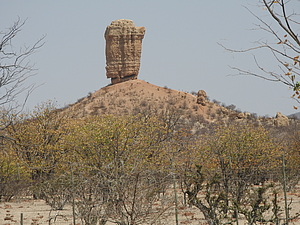
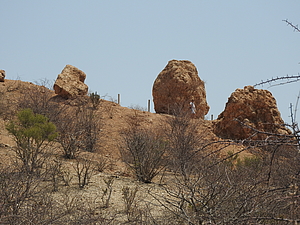
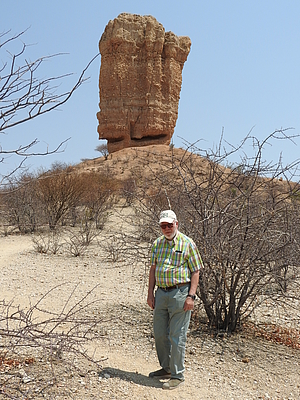
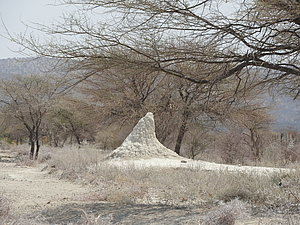
Day 12 - All day safari in Etosha Park. We have seen zebras, giraffes, rhinos, various antelopes (oryx, springbok, eland), kudu, wild cat, hyena, jackal and even a lion and a lioness. First he was lying with his wife peacefully on the sand, but then he began to court her and achieved his satisfaction. When he tried for the third time, she pushed him away and started to leave with dignity, the king of all animals obediently behind her.
Poaching is a major problem in Namibia, as in many other countries. It also occurs in national parks, but sometimes animals pass into non protected areas and thus expose themselves even to a greater danger. A brother of our guide had the horns of rhinoceros grazing on his land removed (common practice to protect the animals because horns are the main reason why poachers are killing them). He wanted to put the horns in a safe at the bank, but the bank refused – they did not want to accept an increased risk of bank robbery. So his brother put them in a safe on his farm. During the week, the robbers came, broke into the safe and carried the horns away. The police did not find out where they came from and who gave them the relevant information.
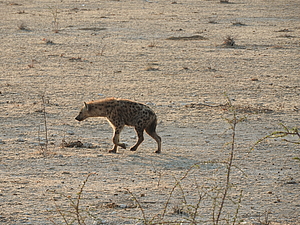

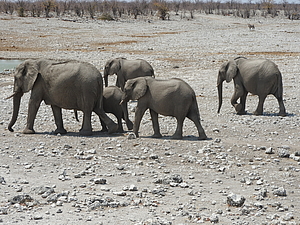
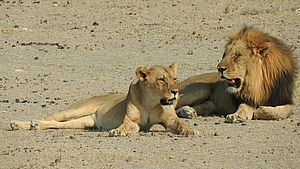
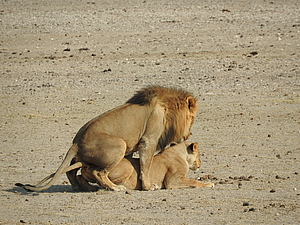
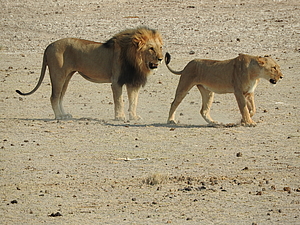
Day 13 - In the morning we set out on a trip through the Etosha Park and at various watering places, both natural and man-made, we saw most of the animals from the previous day, but in larger numbers and herds. We have also seen African fish eagle and various types of vultures. Only the lion and his lioness rested somewhere in hiding.
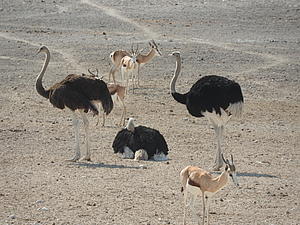
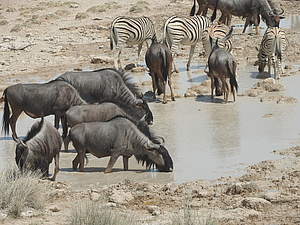
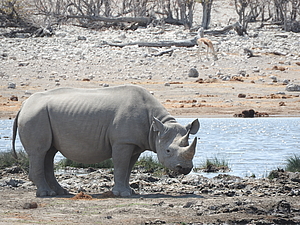
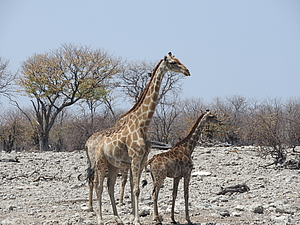
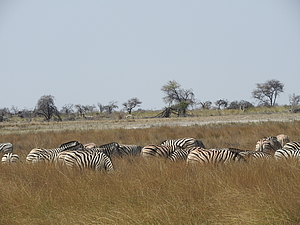
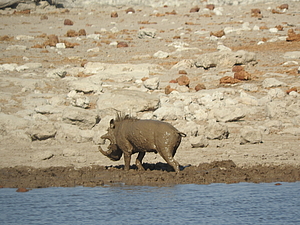
Day 14 - We crossed from the eastern edge of Etosha Park, where we spent the night in the Mokuti lodge, to Windhoek. This time a journey was over 500 km, but mostly on an asphalt road, not on gravel roads on which we had been traveling throughout Namibia almost all the time (daily distances between 250 and 500 km - we have enough of shaking for a long time ahead  ). We stopped in Tsumeb, a town which was in the past an important mining center for copper and other minerals. This past is reminiscent in an interesting local museum.
). We stopped in Tsumeb, a town which was in the past an important mining center for copper and other minerals. This past is reminiscent in an interesting local museum.
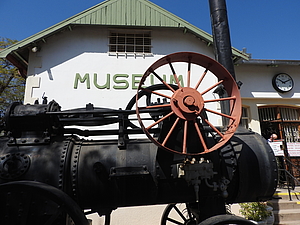
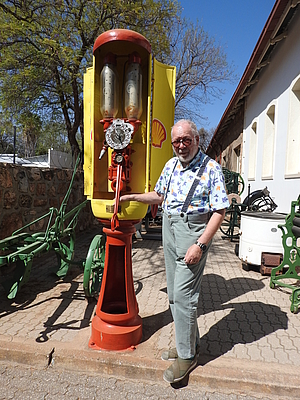
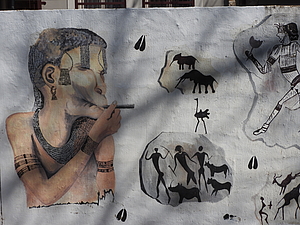
General experience
Accommodation - lodges
All the lodges where we were staying were suitably situated in the middle of nature, some of them were modern, some of them more traditional, all spacious and clean. They had a swimming pool (or a private small pool behind the house). The water was very cold, the reason of that probably being the cold nights in comparison with the daily heat. But after a day of traveling in the heat, it was very nice to swim in the cold water.
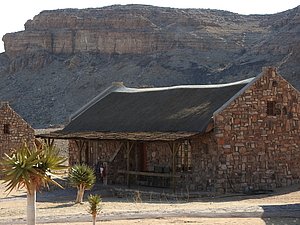
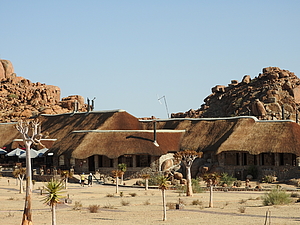


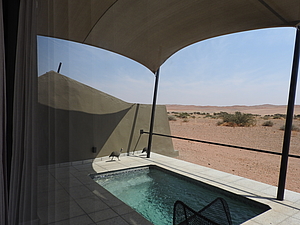
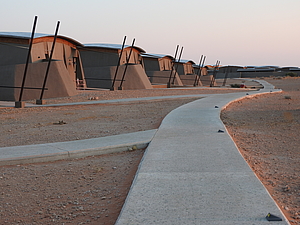

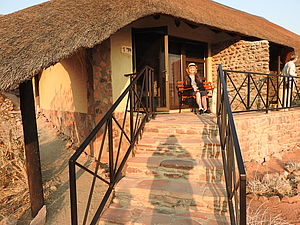
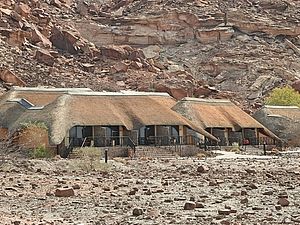
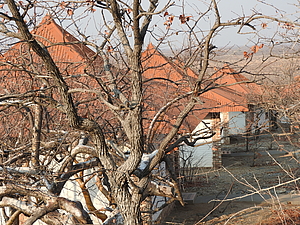
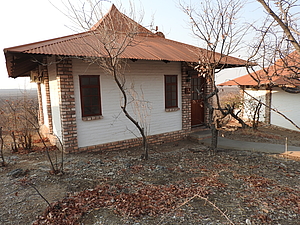
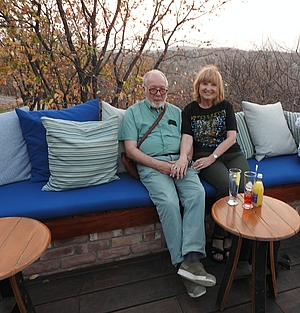
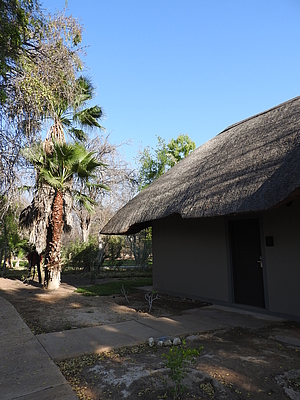
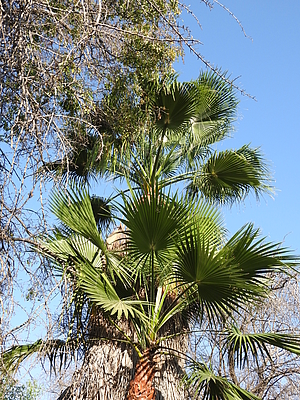
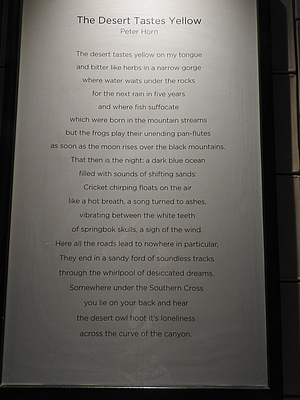
Food
In terms of food, Namibia is the ideal country for carnivores. Vegetable is also served, but really just to complement meat dishes made from kudus, zebras, various antelopes (oryx, springbok, eland) and of course from beef, lamb or pork. I liked oryx steaks most. Namibians love to grill, the barbecue party is called braai in Afrikaans. Another specialty is the air-dried meat called biltong, which is eaten for a snack or just in between like our nuts or potato chips. Otherwise, the national meal that is given to children for breakfast and dinner is milipap. The coastal towns serve delicious fish, and local oysters with lemon and tabasco are especially excellent. Truffles grow in the middle of the Kalahari desert under termite dwellings, but they are harvested after heavy rains from March to June, so unfortunately we did not find them on the menu any more.
Another local specialty are caterpillars known as mopane worms, which live on the leaves of the mopane tree. The wood of this tree is hard, reddish-brown to black and termite resistant, used in construction and in the pharmaceutical industry. The fact that its leaves serve also as food for mopane worms is another plus. The natives collect, dry or roast these worms and consume them for their nutty taste. As we saw them sold only at the stands in the street, I somehow didn't dare to taste them.
German influence is preserved in many restaurants in the cities, so it is possible to order schnitzel, ovarian knuckle, sauerkraut, and bakeries supply apple pie and cherry cake, rye bread and buns.
People
People are pleasant, smiling and ready to sing and dance at any time. In the lodges where we stayed all the staff often came to the scene after dinner, including a cook with a hat and a support staff with a net on their heads, and at the end of the evening they sang and danced to true African rhythms. Even our driver August from the Nama tribe could not only drive well, but also dance well, which he showed at the farewell party.
During a discussion with the former Minister of Agriculture, I asked about current relations with Angola and other countries. There is a customs union and after apartheid was finally removed, relations among neighbor states are friendly. Namibia and Angola celebrate jointly some national holidays and respect each other. Our taxi driver in Windhoek Jamba (meaning elephant) belongs to the Herero because his mother is a Namibian from Herero tribe. His father, however, is an Angolan from Ovambo tribe, who moved to Namibia before Jamba was born. He explained that such cases are not isolated. The minister also told us about his family, he has 4 children, all of whom studied or had an experience abroad, but they are all returning, some with European partners (one of his sons married a German girl, one of his daughters married a man from Finland). The young graduates seem to be returning, which is good, because Namibia certainly has a great shortage of university educated people, which is particularly noticeable with medical doctors. Although basic health care is provided free of charge by the state health system, most hospitals are dependent on doctors from abroad, especially from Cuba, and there is an absolute shortage of nurses as well.
The last day in Windhoek. We visited the Independence Museum. It is a monumental building designed and built by companies from North Korea. Therefore it also evoked contradictory reactions. Not only because it would be appropriate to give the job to local companies, but also because of the typical monumental style both externally and internally (on three floors there are photographs from the pre-colonial era, colonial era and from the era of struggle for independence accompanied by monumental painted frescos). Sam Nujoma is extremely celebrated as father of the nation, his huge statue holding the Namibian constitution stands in front of the museum, and only a little smaller statue is inside.
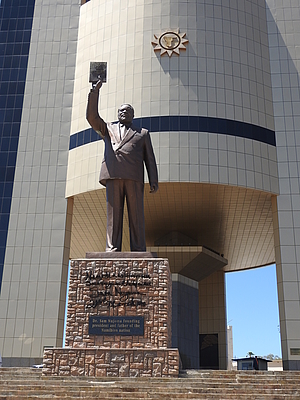
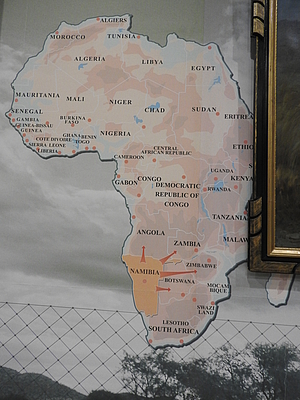
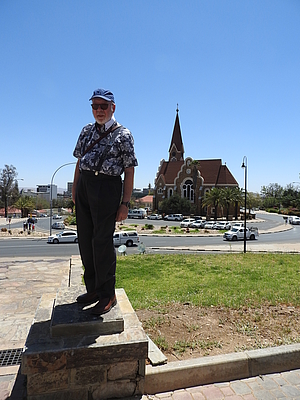
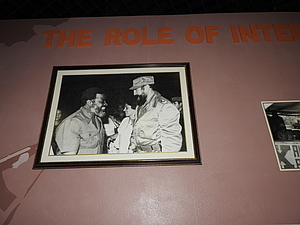
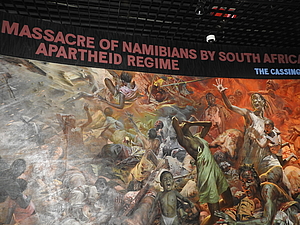
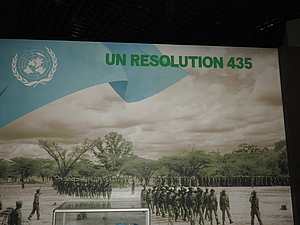
In the museum, we could see the turbulent past of Namibia. Only an hour later we saw what the present looked like. We had a lunch in a pleasant fish restaurant in the courtyard of a shopping mall where black and white children were playing together on a climbing frame, and a number of young students in graduation gowns and hats dined at the tables next to us, celebrating this important day with their parents and friends.
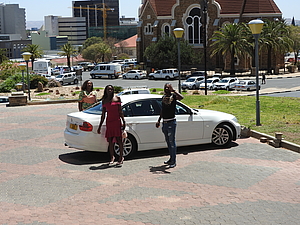
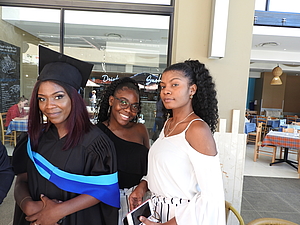
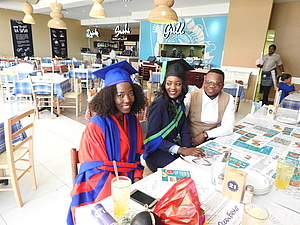

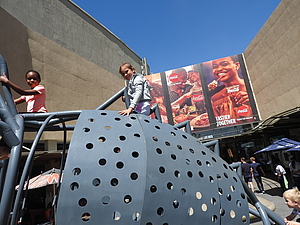
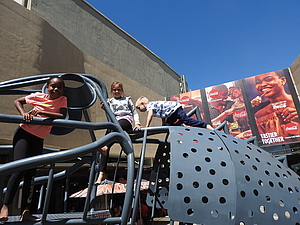
Conclusion:
I am attaching also a sketch of our sightseeing tour in Namibia and a poem that decorated our room in the lodge Desert Grace, Sesriem. I couldn't believe the coincidence. The author of the poem is Czech-born poet Peter Horn! (born 1934, died 2019, emigrated with his parents to South Africa and later became known especially for his anti-apartheid poetry). The poem is called The Desert Tastes Yellow.

The Desert Tastes Yellow
by Peter Horn
The desert tastes yellow on my tongue
and bitter like herbs in a narrow gorge
where water waits under the rocks
for the next rain in five years
and where fish suffocate
which were born in the mountain streams
but the frogs play their unending pan-flutes
as soon as the moon rises over the black mountains.
That then is the night: a dark blue ocean
Filled with sounds of shifting sands:
Cricket chirping floats on the air
like a hot breath, a song turned to ashes,
vibrating between the white teeth
of springbok skulls, a sigh of the wind.
Here all the roads lead to nowhere in particular,
they end in a sandy ford of soundless tracks
through the whirlpool of desiccated dreams.
Somewhere under the Southern Cross
you lie on your back and hear
the desert owl hoot its loneliness
across the curve of the canyon.


